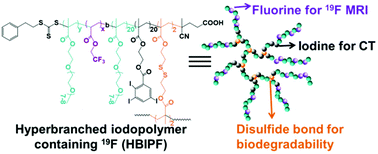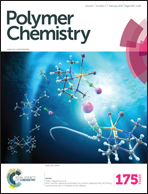Multifunctional hyperbranched polymers for CT/19F MRI bimodal molecular imaging†
Abstract
To develop novel contrast agents for bimodal molecular imaging, we report here the design and synthesis of multifunctional hyperbranched polymers containing iodine and fluorine and their application as CT/19F MRI bimodal imaging contrast agents. A hyperbranched iodopolymer (HBIP), which was composed of 2-(2′,3′,5′-triiodobenzoyl)ethyl methacrylate (TIBMA), poly(ethylene glycol) methyl ether methacrylate (PEGMA) and a degradable crosslinker, was first synthesised by reversible addition–fragmentation chain transfer (RAFT) polymerization. Then the HBIP was chain extended with PEGMA and 2,2,2-trifluoroethyl acrylate (TFEA) to form hyperbranched iodopolymers containing 19F (HBIPFs). A series of HBIPFs with different contents of iodine and fluorine were prepared. Nanoparticles with diameters of 10–15 nm were formed by direct dissolution of HBIPFs in water, and the biodegradability was revealed by the treatment of reducing agents. The radio-opacity of these nanoparticles in aqueous solution was confirmed by in vitro CT experiments, and solutions of the nanoparticles were visualised by 19F MRI. These results suggest that the HBIPFs are attractive candidates for CT/19F MRI bimodal imaging.


 Please wait while we load your content...
Please wait while we load your content...